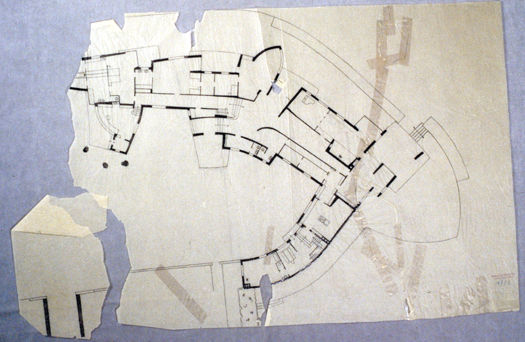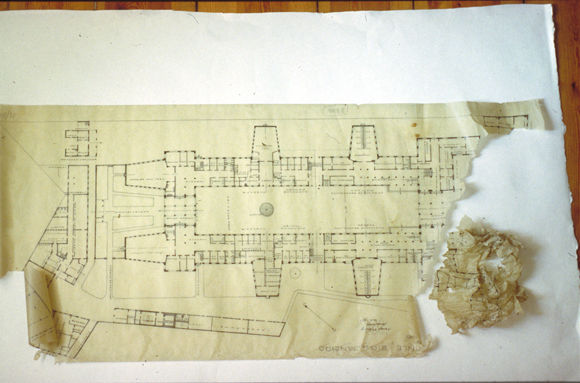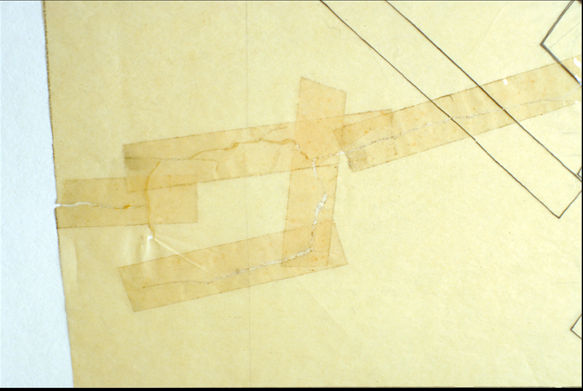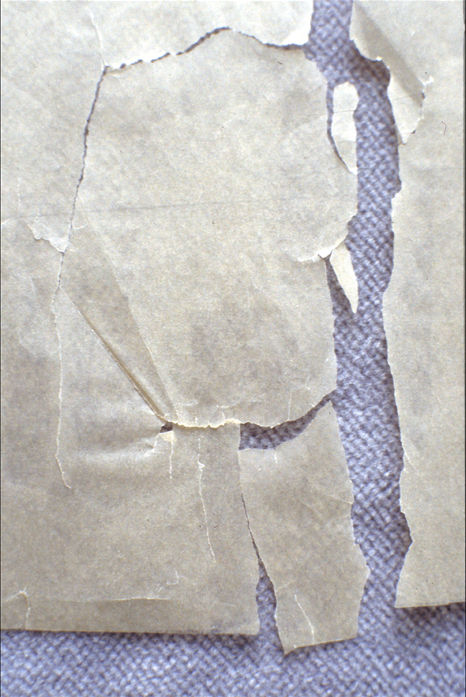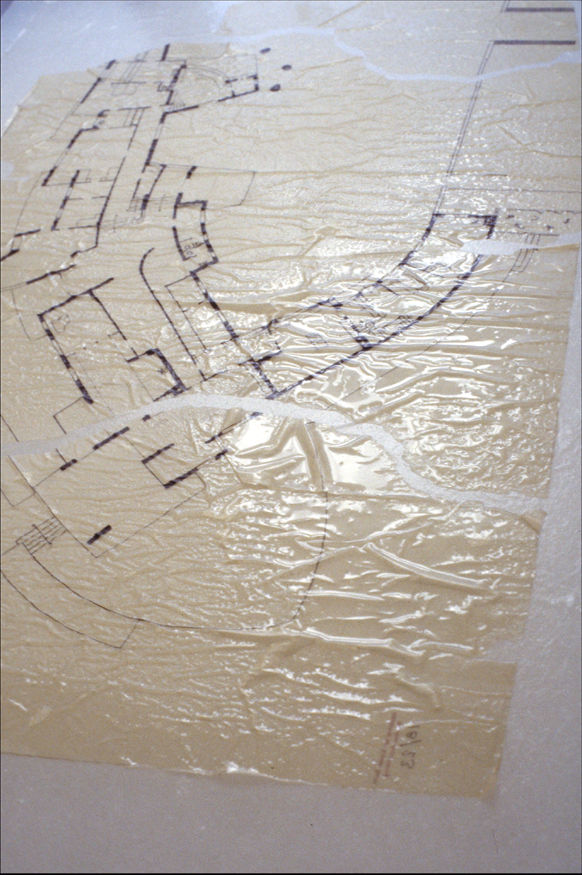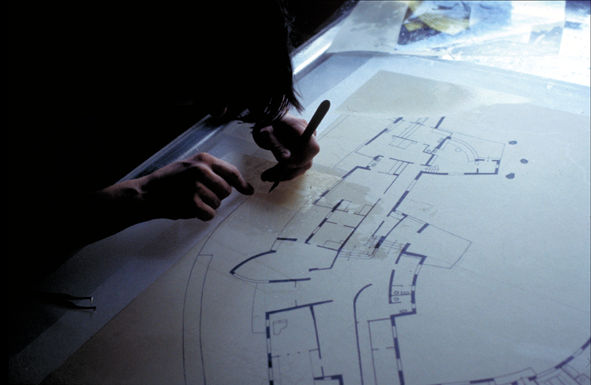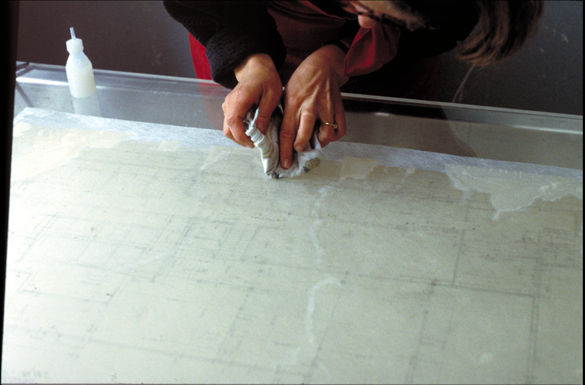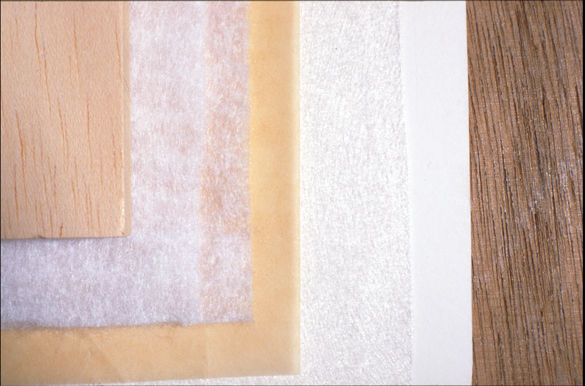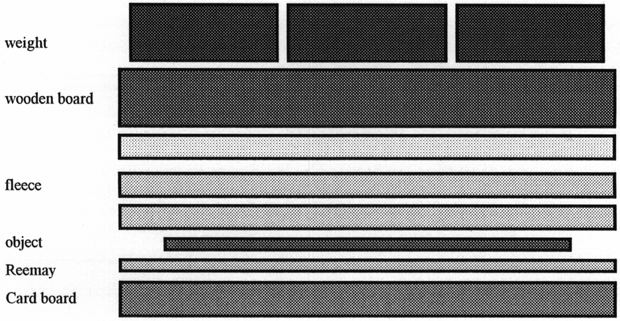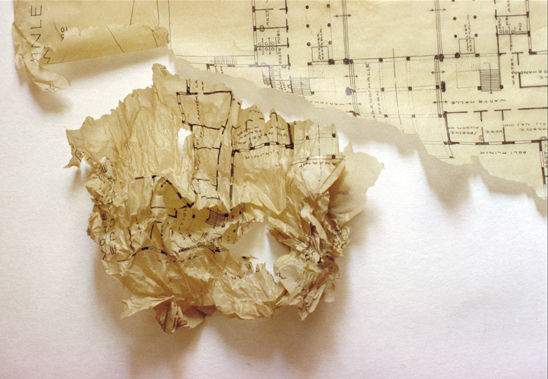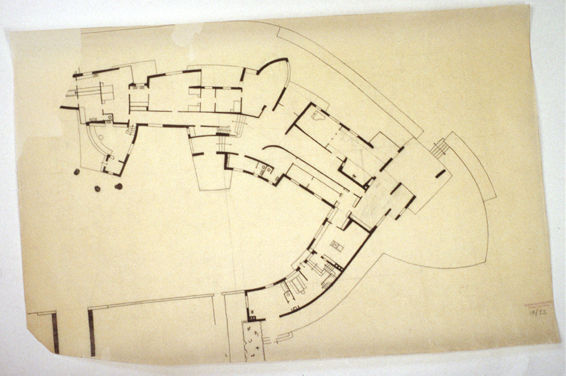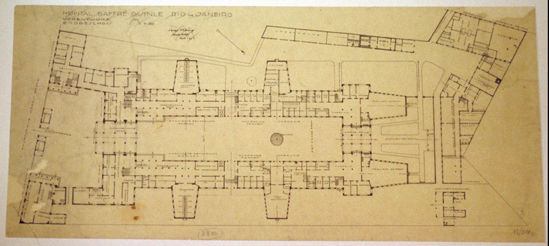Architectural Drawings on Transparent Paper: Modifications of Conservation Treatments
by Hildegard Homburger and Barbara KorbelDrawings on transparent paper are a common working medium for architects. Damage arises through use but it is also related to the particular qualities of the papers. Through the conservation of twentieth-century German architect Hugo Häring's architectural drawings, known paper conservation methods have been further developed. Methods we will discuss include the use of isinglass, the application of paper pulp to tears, and flattening in what will be called a "hard-soft" sandwich.
Fig. 1. Gut Garkau, before treatment: pressure sensitive tape, tears and losses
Fig. 2.Hospital Gaffre Guinle Rio de Janeiro, before treatment: creases, tears and losses
Hugo Häring (1882-1958) was a member of "Der Ring," an important architect group in Berlin. Famous architects like Mies van der Rohe, Walter Gropius and Hans Poelzig were also members. Häring developed the idea of "organic architecture" and built several important buildings of which the Gut Garkau, a farm building near the city of Lübeck, is the most famous. The designs of Gut Garkau and the hospital Gaffre Guinle in Rio de Janeiro are part of the estate of Hugo Häring which is kept in the collection of the Akademie der Künste, Berlin (figs.1-2). The drawings on tracing paper from this estate were chosen for conservation treatment. They dated mainly from the 1920s. The designs are drawn in chalk, ink, and pencil on vegetable parchment paper and impregnated transparent paper.
Prior to treatment, all the drawings were slightly dirty and had the expected damage for such papers. The impregnated paper was badly discolored, the vegetable parchment slightly stained. The paper was brittle and creased and had numerous tears with pressure-sensitive tape attached to the recto and verso. Many of the drawings had losses of varying size.
When working with these papers it was necessary to identify the different types of transparent paper and their special qualities. Therefore, the different production methods will be briefly introduced.
Production Methods
Paper consists of a network of fibers. The single cellulose fibers, which themselves are transparent, are surrounded by air. Falling light is scattered by this air and that is why paper is opaque. In order for the paper to be transparent the air has to be displaced by a material which has an refractive index similar to cellulose. The light is then transmitted rather than scattered. In the history of papermaking, three well-known methods were developed in order to achieve transparent paper: impregnating, acid treating, and overbeating. Each method is briefly discussed here.
Impregnated Paper/Prepared Tracing Paper/Vellum Paper
For many centuries paper was impregnated with materials that had a similar index of refraction such as linseed oil, poppy-seed oil, starch, varnish etc. (Mills 1986; Flieder et al. 1988). Today starch, mineral oils, and synthetic resins are used to raise the transparency of paper (Van der Reyden et al. 1993).
Genuine Vegetable Parchment Paper
From the middle of the nineteenth century, paper was made transparent through treatment with acid, mainly sulfuric acid. Through the effect of the strong acid, a coating of colloidal cellulose is produced on the fibers which is insoluble in water, fills out the pores in the paper, and makes the paper translucent and similar to parchment.
An alkaline neutralization bath follows the acid treatment. Then the paper is calendered so the remaining air in the paper continues to be reduced. As a result of the acid treatment the paper reduces in size and becomes a high quality, strong paper with especially tear-resistant qualities in wet situations and a matte surface. Until the nineteenth century, paper pulp was made mainly from cotton and/or linen fibers; later chemical wood pulp was used. Vegetable parchment was used and produced until the middle of the twentieth century (Flieder 1988; Hoffman 1992; Van der Reyden 1993). Today, only a few places manufacture it, because of the high pollution it produces.
Paper from Overbeaten Fibers
At the end of the nineteenth century cheaper alternatives to vegetable parchment were already being sought. It was discovered that transparency could also be achieved through longer beating of the paper fibers. When cellulose is ground in a larger amount of water, it becomes gelatinized. Overbeating increases the fibrillation, the surface and the contact points between the fibers. With the increased fiber connections, the breaking of light is reduced and transparency is increased (Van der Reyden 1993). When pressed and flattened the paper becomes thicker and more transparent because the light-reflecting interstices between the fibers are reduced.
Imitation parchment, natural tracing paper, and glassine paper differ from each other in the production of the paper pulp because of the choice of material used, the degree to which it is beaten,1 as well as the different pastes, ingredients, and pressing method. The three different types of papers produced by overbeating fibers are reviewed below.
Imitation parchment paper. Imitation parchment paper is produced from overbeaten chemical wood pulp and then calendered.2 It was unsuitable for drawing. To produce a drawing paper, imitation parchment paper had to undergo a soaking in wax or oil. The resulting paper is called, in German, Ölpauspapier (Kotte 1959; Steinkellner 1979).
Natural tracing paper. The majority of modern transparent drawing paper is natural tracing paper. Chemical wood pulp is often used as the fiber substance because the fibers are relatively flat, split open easily, and connect together well in the sheet formation. The paper pulp is overbeaten so that a very even transparent paper is formed. The paper can be calendered and coated on the surface (Flieder 1988; Van der Reyden et al. 1993).
Glassine. The chemical wood pulp for glassine is beaten in a smaller proportion of water than natural tracing paper. The paper is less, or not at all, sized and contains no fillers. A high gloss paper is produced through super calendered drying.
The identification of different types of transparent papers is difficult because the production methods are often combined.
Previous Methods
Because of frequent use and inadequate housing transparent papers are often in such bad condition that lining seems necessary. The problem is that these papers are extremely sensitive to moisture. Therefore, since the 1970s methods have been developed to line this paper without moisture.
A supporting material is prepared with synthetic adhesive which can be activated by heat (tacking iron, hair dryer, heat set press) or solvents. In use are PVA dispersions on Renova paper (Wolff and Hoffenk de Graaff 1982), PVA on polyester web (Jirat-Wasiutynski 1980), BEVA 371 on chiffon-silk (Yates 1984), BEVA 371 on Japanese paper (Stone 1987, Cook, Dennin 1994), and Klucel G on Japanese paper (Flieder et al 1988; Page 1997).
In the 1980s, Japanese lining methods were introduced into Western paper conservation.3 At first they were only applied to Far Eastern objects. With time these Eastern materials, tools and methods were also adapted for the conservation of Western paper because the methods had been successful for a long period of time. Western and Far Eastern methods were united together and also used for the conservation of transparent paper. The transparent paper was lined with thin wheat starch paste and Japanese paper and afterwards it was stretched or flattened under weight (Glaser 1980; Albright and McClintock 1982; McClintock 1986; Huxtable and Webber 1987).
The suction table, ultrasonic humidifier, humidifying chamber and Gore-Tex found their way into paper conservation and made it possible to control the amount of moisture applied to sensitive objects (Keyes 1988). So transparent paper was, for instance, relaxed in a humidity chamber or between Gore-Tex (Yates 1984; Cook and Dennin 1994), flattened on the suction table (Flamm et al. 1990; Singer et al. 1991) or lined on the suction table. The effect of different conservation methods on the quality of the paper was scientifically investigated (Van der Reyden et al. 1992 and 1993; Hoffmann et al. 1992).
This Project's Methods
The goal of our treatment was to alter Hugo Häring's drawings as little as possible visually and aesthetically. It was very important to us that the chosen methods suited the qualities of the paper. Therefore, we used Japanese paper and isinglass for the repairs, and wheat starch paste and Japanese paper for the lining of the objects. The complete wetting of the objects during lining increased the flexibility of the paper. Also the shiny surface of the paper was not lost. The thin lining paper only slightly reduced the transparency. The dimensional change due to the wet lining was not more than 0.1%.
The degree to which the paper dimensions expand and contract depends on the type of paper and the drying and flattening methods. For this reason, we did not use the suction table for drying the papers but flattened the objects on a drying board or pressed them in a hard-soft sandwich. Wheat starch paste and isinglass,4 two natural adhesives which are well known for their good aging qualities were considered. Unlike synthetic adhesives, these natural adhesives complement the movement of the paper. Isinglass has been used successfully to line transparent paper objects (Petukhova 1989). It binds more quickly than wheat starch paste, which made it suitable for local applications. Deformation of the joined tears as a result of moisture could also be reduced with isinglass. Mends with isinglass and linings using wheat starch paste were seen to be suitable because they were not toxic and application was uncomplicated. Also, the repairs and lining could easily be removed with moisture without endangering the object.
Working Stages
Dividing into Groups According to Condition
According to the amount of damage, the transparent papers were divided into those which required only mending and those which need to be lined. In the group to be lined the tears would either be reinforced with Japanese paper after the lining or with paper pulp during the lining.
Dry Surface Cleaning and Removal of Pressure-Sensitive Tape
The surface cleaning was carried out with grated eraser crumbs.
Fig. 3. Detail Gut Garkau, before removal of tape
Fig. 4. Detail Gut Garkau, after removal of tape
The plastic carrier of the pressure sensitive tapes was mechanically removed from many of the drawings; some needed the application of warmth to ease this process. The remaining adhesive was either removed with a rubber-cement eraser or with alcohol, acetone, or ethyl acetate (Reissland 1995; O'Loughlin and Stiber 1992; Smith et al. 1984) (figs. 3-4).
Mending and Fills
Local repairs using Japanese paper and isinglass. To make the Japanese paper mends as invisible as possible the paper was torn in strips with fibrous, feathered edges. When the mend was adhered to the drawing only the center of the strip was stuck down. The technique works because the fibers at the edges of the mending strip stand up and are not visible.
The tears were pasted approximately 1-2 mm along the edges with isinglass, then the Japanese paper was laid over the tears and pressed down under a layer of Reemay applying light pressure with the fingers. The pressure of a finger facilitates the absorption of the moisture and allows the treated part of the tear to expand and contract with more ease than when using a rigid weight. Sand-bags are also useful but the hand is more sensitive and can judge the amount of pressure better.
Completion of missing areas/preparation of infill paper. The expansion and contraction qualities of the infill paper has to be as similar as possible to the original paper. If it is not similar the area can buckle at the joint of the two papers. In order to find a corresponding paper we had to choose a modern transparent paper of the same weight because old papers were not available. Different papers of the same weight can have different expansion and contraction charac- teristics. We did tests to ascertain the correct paper. The suitable paper was either toned and dried in an oven or colored with dyes from Bayer. Both methods have different advantages. Artificial aging gives characteristics to the infill paper that are similar to the drawing paper. With the Bayer dyes, however, a wider range of tones can be produced.
Filling losses. The toned paper was laid on Mylar and placed over the missing area, the fills were cut edge to edge with a scalpel and then adhered to the object with strips of Japanese paper and isinglass. The tension produced by this technique of edge-to-edge fill is lower than a fill that overlaps the drawing paper and for that reason causes less stress and cockling.
Lining
Fig. 5. Gut Garkau, laid over a film of water
Fig. 6. Gut Garkau, blotted down during the cutting out of infill on Mylar
Preparation. A work surface of Plexiglas was prepared with a layer of Reemay, which was brushed with water to leave a film of water.5 The object was laid on top of this with the drawing facing downwards and sprayed immediately with water. Without further manipulation the paper was given time to expand. At the same time the repair paper was also expanded over a piece of Mylar. The water film makes the positioning of tears and folds easier (fig. 5). The object was covered with Reemay and brushed out flat with the Nadebake.6 Transparent paper has a tendency to wrinkle up despite being brushed out flat so the drawings were blotted down on the surface. The blotting paper absorbed the degradation products from the paper. The fills were prepared and cut as stated before. A light table made the application of the fills easier (fig. 6).
Fig. 7. Gut Garkau, pulp application
Reinforcement of tears. The edges of the tears of the lined objects tended to lift up after drying when using a thin lining paper. Two techniques were used to deal with this problem. The first included laying a strip of Japanese paper over the tears with isinglass. This was done after the drying of the lined object. The second technique was to apply paper pulp to the tears before the expanded object was lined. The tears and edges were brushed on the back of the object with wheat starch paste. To achieve the best transparency in the paper pulp application, an industrial transparent paper pulp was used. This pulp produces a highly transparent, white paper. To make the pulp fills visually match the paper, colored fibers7 were added to the pulp. The beaten mixture of fibers was applied to the tears with a drip bottle and the excess moisture was absorbed with a tea-towel (50% linen:50% cotton,8 fig.7). The paper pulp should not be too thick. If it is, it will be visible from the front and produce too much tension. The suction table is not suitable for this because the paper at the tears would dry out too quickly and shrink. Frequent spraying might work but is not practical and would change the characteristics of the paper too much (Van der Reyden et al. 1993).
Lining. The thinly pasted out lining paper was centered over the object on a Mylar carrier and brushed down with a Nadebake. Then the Mylar was lifted up following the grain direction of the object and the Japanese paper was brushed firmly down to remove any air bubbles.
The lined object was blotted to draw out the moisture and to ensure that the papers formed a good bond together. Afterwards the object was lifted up from the table using the Reemay support and laid out on a felt. The Reemay was taken off because it holds too much moisture. The recto of the transparent paper was blotted carefully and a second felt was laid over it. The object was left to dry overnight. When transparent paper dries, it shrinks to its original size or slightly smaller.
Flattening in a Hard-Soft Sandwich
There are certain paper objects that require special flattening. Examples are sensitive papers like tracing papers and Japanese papers. Papers with severe distortions such as folds, buckling mends and open tears are also problematic. Papers with uneven expansion qualities require special flattening techniques as do papers with plate marks, impasto painting, or papers with rough surfaces.
Flattening these papers between blotting paper might cause creases in the paper or might compress the paper surface or thick paint layers. Stretching is sometimes the alternative (Huxtable and Webber 1987), but it involves the application of stretching margins to the object, which is often undesirable.
The technique we call "hard-soft sandwich" is another alternative that does not require margins or any other addition to the object. The procedure is a very gentle way to flatten heavily creased or sensitive paper objects and it is very easy to do.
Procedure
Fig. 8. Construction of the hard-soft sandwich
Fig. 9. Diagram, cross section of the hard-soft sandwich
The object is relaxed in a Gore-Tex sandwich or moisture chamber9 and laid on a sheet of Reemay on top of a hard museum-quality mounting board. It is then covered with a layer of soft polypropylene fleece10 and smoothed through the fleece with a Nadebake brush. Depending on the distortion of the paper object, up to four layers of fleece are put on top of the first layer. This means a more heavily distorted object requires more layers of polypropylene fleece. A wooden board and weights are placed on top (figs. 8-9). More weight is required than with a standard pressing between blotting paper. Despite the heavier weight, plate edges and thick color layers, etc., are not changed during this pressing process. The paper object lies flat and free of tension.
Some papers might require repeating of the process. In subsequent flattenings the number of fleece layers might be reduced. With very large objects several pieces of fleece can be laid next to each other. It is important that no spaces remain between the fleece. It is safe to overlap the pieces of fleece because when weighted down they press into each other and produce an even pressure overall.
The hard-soft sandwich is also suitable for local treatments. For this however, the sandwich has to be considerably larger than the treated paper area. This way the polypropylene fleece evens out the tension between the dampened and dry areas.
We used this method to flatten lined tracing papers, unlined tracing papers, repaired drawings and completed objects. The papers were placed in a Gore-Tex sandwich for 5-20 minutes according to the paper type.
Fig. 10. Hospital Gaffre Guinle Rio de Janeiro, before flattening
Fig. 11. Hospital Gaffre Guinle Rio de Janeiro, after repairs and flattening
Some transparent papers had to be partially flattened before they could be dry cleaned and repaired (figs. 10-11).
Final Word
The methods described here were improved and developed during the working process. After observing that the lined objects reacted more to climate changes than the unlined objects, we decided only to line the extremely weakened sheets. The Hugo Häring drawings were adequately stabilized with the repairs of Japanese paper and isinglass. They were also treated like art objects and stored in museum quality mounts.
Fig. 12. Gut Garkau, after treatment
The results of the hard-soft sandwich were so good that the majority of the objects received this treatment and were not stretch-dried.
Fig. caption. Hospital Gaffre Guinle Rio de Janeiro, after treatment
After the paper pulp technique to reinforce repairs while lining was developed, it was favored because it took less time than reinforcing tears with strips of Japanese paper after lining. We did tests to fill missing areas with transparent paper pulp and the tests showed many promising results. However in the tests this transparent paper pulp application technique caused very strong tension in the paper. We believe that after more investigation into mixing different ratios of the paper pulp and other contents, this method could be a new alternative to the techniques used up until now.
Acknowledgements
We would like to thank Annette Kessler for her assistance with the development of the paper pulp application techniques during her internship. We would like to thank Gemma Caney for her support with the translation.
Notes
1. Expansion and contraction of the paper in changing relative humidity rises proportionally to the grade of beating of the pulp.
2. At the end of the nineteenth century this method was discovered by accident: machines stopped during paper production. The paper pulp stayed longer in the hollander and was overbeaten, the resulting paper was transparent. This paper was called Pergamyn.
3. Hyogu: The Japanese Tradition in Picture Conservation, ed. Paul Wills and Nicholas Pickwoad, The Paper Conservator 9 (1985).
4. In Russia the use of isinglass is not only common in painting conservation but also in paper conservation. Isinglass is a hot glue which is produced from the bladder of the sturgeon fish. It has a pH value around 6 and very good aging characteristics. It is one of the best quality protein glues with a very weak color, a high elasticity and forms a transparent film. The quality of the glue depends on the origin of the bladder and its production method (Foskett 1994).
A 2% solution was used; 0.4 grams isinglass were soaked for several hours in 20 ml water and then dissolved in a double boiler.
5. Reemay has a less smooth surface than Hollytex. It is very porous and therefore water permeable. Hollytex is not as suitable because the object does not glide over the surface as easily when being brushed out.
6. Japanese brushes were used: Nadebake, smoothing brush, and Noribake, paste brush. See: A. Thompson, Japanese brushes for conservation, The Paper Conservator 9 (1985): 42-53.
7. A tracing paper factory kindly sent us a sample bottle of their fiber pulp but they asked us not to publish their name. One liter of pulp lasts a very long time and is enough for many objects. Conifrazell, dried chemical wood pulp, from Claasen Papertronics was dyed with colors from Bayer and added to the tracing paper pulp.
8. Dutch method from van Oort (see: Otto Wächter, Restaurierung und Erhaltung von Büchern, Archivalien und Graphiken, Wien 1977, 136).
9. If the paper is sprayed it does not moisten as evenly as in a Gore-Tex sandwich.
10. Instead of polypropylene fleece other materials with similar properties could be used.
References
Albright, Gary E., and Thomas K. McClintock. 1982. The treatment of oversize paper artifacts. The Book and Paper Group Postprints 1:42-53.
Bachmann, Konstanze. 1983. The treatment of transparent paper: a review. ?The Book and Paper Group Annual, 2:3-13.
Bachmann, Konstanze. 1986. Transparent paper before 1850: history and conservation problems. In Conference notes: new directions in paper conservation, 10th Anniversary Conference, Oxford, ed. Alan Howell. Leigh, U.K.: Institute of Paper Conservation. D61.
Bush, Andrew. 1986. Conservation of 19th century tracing papers in the National Maritime Museum. In Conference notes: new directions in paper conservation, 10th Anniversary Conference, Oxford, ed. Alan Howell. Leigh, U.K.: Institute of Paper Conservation. D61-62.
Cook, Paul, and Julie Dennin. 1994. Ships plans on oil and resin impregnated tracing paper: a practical repair procedure. The Paper Conservator 18:11-19.
Flamm, V., C. Hofmann, S. Dobruskin, and G. Banik.1990. Conservation of tracing papers. In Preprints, ICOM Committee for Conservation, 9th Triennial Meeting, Dresden. 463-467.
Flieder, Francoise, B. Guineau, Claude Laroque, B. Liebard, et al. 1988. Analysis and restoration of old transparent papers. In The Conservation of Historic and Artistic Works on Paper, ed. Helen Burgess. Ottawa: Canadian Conservation Institute. 235-244.
Foskett, Sarah. 1994. An Investigation into the Properties of Isinglass. SSCR Journal 5(4):11-14.
Glaser, M.T. 1980. Conservation of drawings by Frank Lloyd Wright at the New England Conservation Center. In AIC Preprints, American Institute for Conservation 8th Annual Meeting, San Francisco: AIC. 20-25.
Hofmann, C., D. van der Reyden, and M. Baker. 1992. The effect of three humidification, flattening and drying techniques on the optical and mechanical properties of new and aged transparent papers. Conference Papers: Manchester 1992, ed. Sheila Fairbrass. Leigh, U.K.: Institute of Paper Conservation. 247-256.
Homburger, H. and B. Korbel. 1998. Architekturzeich-nungen auf Transparentpapier. Restauro 7:462-467.
Huxtable, Merryl, and Pauline Webber. 1987. Some adaptations of Oriental techniques and materials used in the Prints and Drawings Conservation Department of the Victoria and Albert Museum. The Paper Conservator 11:46-57.
Jirat-Wasiutynski, Thea. 1979. Sprayed polyvinyl acetate heat seal adhesive lining of pen and iron-gall ink drawings on tracing paper. Journal of the American Institute for Conservation 19(2):96-102.
Keyes, Keiko Mizushima. 1994. Some practical methods for the treatment with moisture of moisture-sensitive works on paper. In The Conservation of Historic and Artistic Works on Paper, ed. Helen Burgess. Ottawa: Canadian Conservation Institute. 99-108.
Kotte, H. 1959. Welches Papier ist das? Stuttgart.
McClintock, Thomas, K. 1986. The drawings of Frank Lloyd Wright: conservation of the works on tracing paper. In Conference notes: new directions in paper conservation, 10th Anniversary Conference, Oxford, ed. Alan Howell. Leigh, U.K.: Institute of Paper Conservation. D63-64.
Mills, John. 1986. Analysis of some 19th century tracing paper impregnants and 18th century globe varnishes. In Conference notes: new directions in paper conservation, 10th Anniversary Conference, Oxford, ed. Alan Howell. Leigh, U.K.: Institute of Paper Conservation. D62-63.
O'Loughlin, E., and L. S. Stiber. 1992. A closer look at pressure sensitive adhesive tapes: update on conservation strategies. Conference Papers, Manchester 1992, ed. Sheila Fairbrass. Leigh, U.K.: Institute of Paper Conservation. 280-287.
Page, Susan. 1997. Conservation of nineteenth-century tracing paper: a quick practical approach. The Book and Paper Group Annual 17:67-73.
Petukhova, Tatyana. 1989. Potential application of isinglass adhesive for paper conservation. The Book and Paper Group Annual 8:58-61.
Reißland, Birgit. 1995. Die Entfernung von Doppelkle-bebändern auf Filzstiftzeichnungen. IADA Preprints, IADA 8th International Congress, Tübingen. 241.
Rundle, Christopher D. 1986. The composition and manufacture of modern tracing papers. In Conference notes: new directions in paper conservation, 10th Anniversary Conference, Oxford, ed. Alan Howell. Leigh, U.K.: Institute of Paper Conservation. D64-65.
Singer, H., S. Dobrusskin, and G. Banik. 1991. Behand-lung wasserempfindlicher Objekte mit Gore-Tex. Restauro 2:102-111.
Smith, Merrily A.; Norvell M. M. Jones, II; Susan L. Page; and Marian Peck Dirda. 1983. Pressure-sensitive tape and techniques for its removal from paper. The Book and Paper Group Annual 2:95-113.
Steinkellner, C. 1979. Transparentpapier I. Maltechnik Restauro 1:9-13.
Steinkellner, C. 1979. Transparentpapier II. Maltechnik Restauro 2:113-117.
Van der Reyden, Dianne, and Mary Baker. 1995. Genuine vegetable parchment paper: effects of accelerated aging on some physical and chemical properties. In MRS Postprints, Cancun. MRS.
Van der Reyden, Dianne, Christa Hofmann, and Mary Baker. 1992. Some effects of solvents on transparent papers. In Conference Papers: Manchester 1992, ed. Sheila Fairbrass. Leigh, U.K.: Institute of Paper Conservation. 234-246.
Van der Reyden, Dianne, Christa Hofmann, and Mary Baker. 1993. Effects of aging and solvent treatments on some properties of contemporary tracing papers. Journal of the American Institute for Conservation 32(2):177-206.
Wächter, O. 1977. Restaurierung und Erhaltung von Büchern. Archivalien und Graphiken, Verlag Böhlau. 136.
Weidner, M. K. 1974. A vacuum table of use in conservation. AIC Bulletin 14:115.
Wolff, Charlotte E. M., and Judith H. Hofenk De Graaff. 1982. Eine Methode, um Transparentpapier zu kaschieren. Maltechnik Restauro 3:198-203.
Yates, Sally Ann. 1984. The conservation of nineteenth-century tracing paper. The Paper Conservator 8:20-39.
Die Fabrikation fettdichter Papiere. 1923. Wochenblatt für Papierfabrikation, 22:1534-1535.
Suppliers
Conifracell
Claasen Papertronic
Landsberger Str. 80
D-45219 Essen
Tel. 02054/130, Fax 131790
Germany
Gore-Tex
Deffner & Johann
Mühläcker 13
D-97520 Böthlein
Tel. 09723/2044, Fax 4889
Germany
Isinglass
Dr. Georg Kremer, Farbmühle
D-88317 Aichstetten
Tel. 07565/1011 or 91120, Fax 1606
E-mail: kremer.pigmente@t-online.de
Germany
Japanese paper
Paper Nao 4-37-28 Hakusan Bunkyo-ku
Tokyo 112-0001
Japan
Polypropylene fleece
Per Laursen
Ny Strandvej
DK-3050 Humlebak
Denmark
Reemay 2006, 20g/qm, Filtervlies 290
Polo Filter
Heinrich Heine Str. 50
D-28211 Bremen
Germany
Hildegard Homburger
This article was originally published in German as "Architekturzeichnungen auf Transparentpapier," Restauro 7 (1998): 462-467.
Paper Conservator
Berlin, Germany
Barbara Korbel
Paper Conservator
Deutsches Historisches Museum
Berlin, Germany
Publication History
Received: Fall 1999
This paper was submitted independently by the author, and was not delivered at the Book and Paper specialty group session of the AIC Annual Meeting. It first appeared in German in Restauro. Beyond whatever peer-review has been done by Restauro, the article has not received any further peer-review
